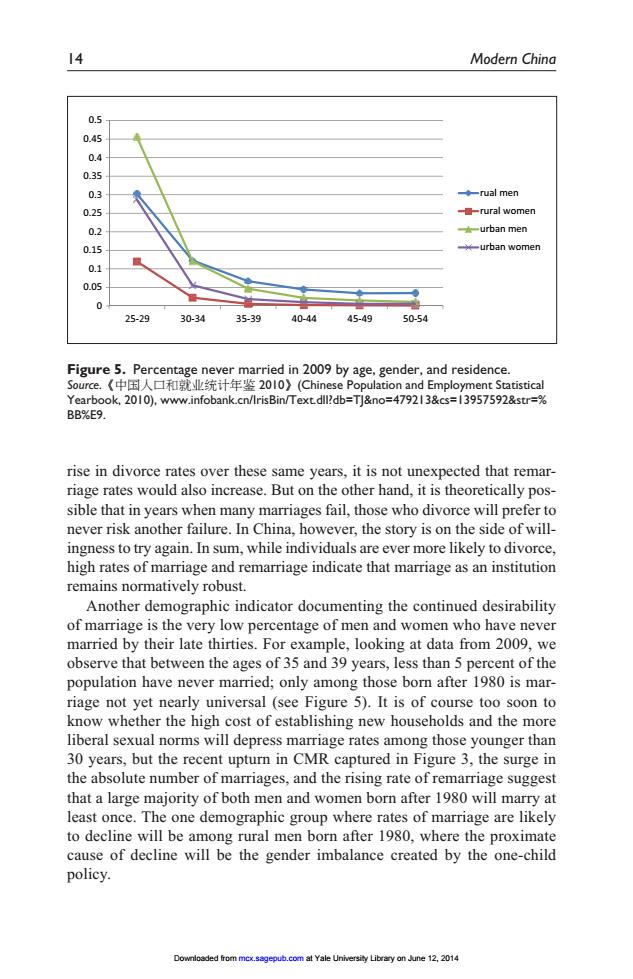正在加载图片...

14 Modern China 0.5 0.45 0.4 0.35 0.3 ◆-ual men 0.25 量-ural women 0.2 urban men 0.15 urban women 0.1 0.05 0 25-29 30-34 35-39 40-44 45-49 50-54 Figure 5.Percentage never married in 2009 by age,gender,and residence. Source.《中国人口和就业统i计年鉴2ol0》(Chinese Population and Employment Statistical Yearbook,2010),www.infobank.cn/lrisBin/Text.dll'db=T]&no=479213&cs=13957592&str=% BBXE9 rise in divorce rates over these same years,it is not unexpected that remar- riage rates would also increase.But on the other hand,it is theoretically pos- sible that in years when many marriages fail,those who divorce will prefer to never risk another failure.In China,however,the story is on the side of will- ingness to try again.In sum,while individuals are ever more likely to divorce, high rates of marriage and remarriage indicate that marriage as an institution remains normatively robust. Another demographic indicator documenting the continued desirability of marriage is the very low percentage of men and women who have never married by their late thirties.For example,looking at data from 2009,we observe that between the ages of 35 and 39 years,less than 5 percent of the population have never married;only among those born after 1980 is mar- riage not yet nearly universal (see Figure 5).It is of course too soon to know whether the high cost of establishing new households and the more liberal sexual norms will depress marriage rates among those younger than 30 years,but the recent upturn in CMR captured in Figure 3,the surge in the absolute number of marriages,and the rising rate of remarriage suggest that a large majority of both men and women born after 1980 will marry at least once.The one demographic group where rates of marriage are likely to decline will be among rural men born after 1980,where the proximate cause of decline will be the gender imbalance created by the one-child policy. Downloaded from mcx.sagepub.com at Yale University Library on June 12,201414 Modern China 0 0.05 0.1 0.15 0.2 0.25 0.3 0.35 0.4 0.45 0.5 25-29 30-34 35-39 40-44 45-49 50-54 rual men rural women urban men urban women Figure 5. Percentage never married in 2009 by age, gender, and residence. Source.《中国人口和就业统计年鉴 2010》(Chinese Population and Employment Statistical Yearbook, 2010), www.infobank.cn/IrisBin/Text.dll?db=TJ&no=479213&cs=13957592&str=% BB%E9. rise in divorce rates over these same years, it is not unexpected that remarriage rates would also increase. But on the other hand, it is theoretically possible that in years when many marriages fail, those who divorce will prefer to never risk another failure. In China, however, the story is on the side of willingness to try again. In sum, while individuals are ever more likely to divorce, high rates of marriage and remarriage indicate that marriage as an institution remains normatively robust. Another demographic indicator documenting the continued desirability of marriage is the very low percentage of men and women who have never married by their late thirties. For example, looking at data from 2009, we observe that between the ages of 35 and 39 years, less than 5 percent of the population have never married; only among those born after 1980 is marriage not yet nearly universal (see Figure 5). It is of course too soon to know whether the high cost of establishing new households and the more liberal sexual norms will depress marriage rates among those younger than 30 years, but the recent upturn in CMR captured in Figure 3, the surge in the absolute number of marriages, and the rising rate of remarriage suggest that a large majority of both men and women born after 1980 will marry at least once. The one demographic group where rates of marriage are likely to decline will be among rural men born after 1980, where the proximate cause of decline will be the gender imbalance created by the one-child policy. Downloaded from mcx.sagepub.com at Yale University Library on June 12, 2014